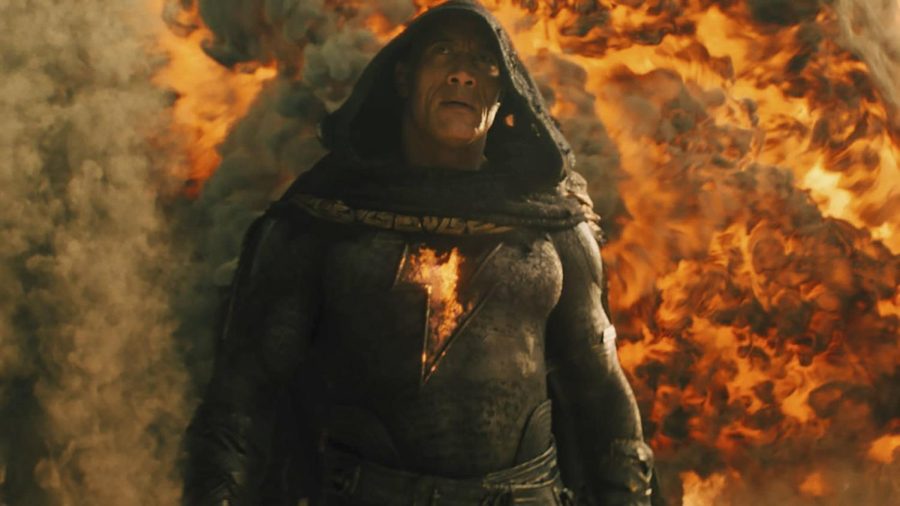With the Oscars upon us, it’s only fair to assess the nominees in the ceremony’s most famous category: Best Picture. In our extensive analysis of these 10 films, we created the acronym CADE — which stands for Cinematography, Acting, Directing and Entertainment Value — to be our judging metric
“All Quiet on the Western Front” (Blythe)
Cinematography
The cinematography of “All Quiet on the Western Front” is absolutely gorgeous. Yes, a lot of the film is incredibly graphic and portrays catastrophic events, but that doesn’t mean that it cannot be done in a way that is artistic and thoughtful. In my opinion, war movies tend to have some of the best cinematography out there (take “1917,” for example), and “All Quiet…” is simply no exception. There’s a reason why it has a Best Cinematography nomination as well, and I’m looking forward to watching the 20-minute “behind the scenes” segment that Netflix recently released on the making of the film. 10/10
Acting
Despite being entirely in German, even us English speakers can tell that the acting in the movie is superb. The actors’ facial expressions alone are enough to convey the strife, pain and mind-numbing trauma that these young men must endure for a war in which they’re just pawns. The movie primarily revolves around Paul, played by Felix Kammerer. While he did not directly receive an acting nomination for his role, Kammerer’s piercing blue eyes and facial expressions in the close-up shots of him watching all of his friends die are enough to make your heart feel like it’s being ripped out of your chest. I’d say that he has a bright future ahead of him. 8/10
Directing
I have no complaints about Edward Berger’s directing. I already said the movie was gorgeous, and I appreciate that Berger took the time to really stress how gruesome this war truly was. Some war movies tend to brush over the violence and just make the whole film a hero’s journey, but Berger leans into the macabre and gruesome aspects — it’s one of the few recent war movies that keeps this in mind. 10/10
Entertainment Value
I refuse to watch the dubbed version of films because I feel like it causes them to lose some of their “sparkle,” but the movie lost me a few times because it was in a foreign language. It’s no fault of the film’s content — just my attention span. 7/10
Overall Rating: 8.7/10
“Avatar: The Way of Water” (Charlie)
Cinematography
A large part of the first Avatar’s appeal was its visual beauty and its technical prowess, and “The Way of Water” is gorgeous as well. I usually do not enjoy films that rely heavily on CGI because I am unsure whether or not the technology will ever be completely convincing visually. However, it is hard to avoid with a story of this sort, and I cannot deny how cinematographically impressive Avatar manages to be. 9/10.
Acting
The performances in this film are good, though it is difficult to compete against the likes of Cate Blanchett in “Tar” or Colin Farrell in “The Banshees of Inisherin.” I will give the actors credit where it is due: Acting while wearing the full technological suit required to create the visual effects of “The Way of Water” is an art in and of itself, and the whole cast manages to still deliver good performances. 7/10.
Directing
Cameron has imagined the universe of “Avatar” for decades at this point, and he succeeds in helping both the characters and the audience understand this world. As mentioned previously, Cameron also deserves credit for extracting good performances from his actors despite the technological settings the crew shot in. There are aspects of the film that seem to hint at future narratives, as the series is slated to have a total of five installments. A full critique cannot be made until the series is complete, so patience is in order. 7/10
Entertainment Value
“Avatar: The Way of Water” is a long movie. It is, in fact, the longest nominee on this list, clocking in at three hours and 12 minutes. In looking at the gross earnings — $2.174 billion — audiences did not seem to mind. Long movies are inherently very slowly paced, though “The Way of Water” keeps things moving relatively well. I can promise that really immersing oneself into the world of the film is certainly a rewarding and complete experience. 7/10
Overall: 7.5/10
“The Banshees of Inisherin” (Charlie)
Cinematography
Like the rest of the movie, the cinematography of “Inisherin” is simple and subtle, but allows us to learn about the town and the island very well. The cinematography also experiments with depth in interesting ways. Seeing the scale of the cliffs next to a human figure is really incredible to see. 8/10.
Acting
All of the performances in this film are incredible. The film is a study of character, and the actors make sure to put their all into their roles. Colin Farrell and Brendan Gleeson shine as the two leading men, and their supporting cast offers just as compelling and rich portrayals of their own characters. Every choice of movement, timing and vocal tone seems intentional and meaningful. It is really a treat to see such great performers working together. 10/10.
Directing
Martin McDonagh wrote and directed this film, so I will discuss both the direction and the script here. The direction shines: It is clear that McDonagh has communicated his understanding of his characters to the actors, allowing them to bring the characters to life for the audience. McDonagh’s script is also, in my opinion, the best of the year. Its use of language, especially in the Irish dialect, is rhythmic and creative in ways that I have never seen before. It is so enjoyable to just listen to these characters talk to one another. The script is also subtle and elusive in that, just like the performances, we feel as though we are just taking a glance into life in Inisherin. 10/10.
Entertainment Value
This is a slower movie, and even though its runtime is short, it is difficult at times to stay focused. Slower-paced, dialogue-based movies are becoming increasingly rare as our societal attention span shrinks, so a film like “Insherin” may struggle with today’s audience. That being said, the film does not often meander, and while it is heavy on dialogue and low on action, the pace is steady and strong. 8/10.
Overall: 9/10
“Elvis” (Blythe)
Cinematography
Baz Luhrmann, director of frenetic visual experiences such as “Moulin Rouge!” and “The Great Gatsby,” loves using sweeping camera movements alongside vibrant colors to give his viewers an experience akin to being at an amusement park. “Elvis” is no exception. It’s practically impossible to be bored when watching the film (which is probably why I saw it in theaters three times). Sometimes Luhrmann’s choice of shots makes me a little motion sick, but it worked well in “Elvis.” 9/10
Acting
Most of the acting in “Elvis” is fairly basic. Even Tom Hanks as the terrible Colonel Tom Parker felt a little mediocre. Austin Butler delivers the most astounding performance of all time as Elvis Presley. With a performance endorsed by Priscilla Presley herself, I think Butler has an incredibly strong chance of winning Best Actor this year. 7/10
Directing
Luhrmann’s strongest asset is his unique style of filming. In real life, Elvis’ performances were hardly ever caught straight-on by the camera. He also does a fantastic job of capturing the many sides of Elvis, from the mystical, suave celebrity to the sad, helpless little boy that lived inside of him. 8/10
Entertainment Value
The entertainment value of “Elvis” is incredibly high. The movie is bright, lively and fast-paced. Not to mention, it also features fantastic music. What else can you ask for? 10/10
Overall: 8.5/10
“Everything Everywhere All at Once” (Charlie)
Cinematography
The cinematography of EEAO is quick, quirky and dynamic — impressively reflecting the overall fantastical feel of the film. The production team took a lot of risks, and luckily, a lot of them worked out. The use of colors in the film is something that really stood out to me, especially the instances of juxtaposition between well-lit versus dark, warm colors versus cold colors and white versus black. 9/10.
Acting
The performances in EEAO are getting a lot of buzz — and for good reason. Four separate actors are nominated for Best Actor in a Supporting Role, Best Actress in a Leading Role and Best Actress in a Supporting Role. Michelle Yeoh shines in this film in ways I did not expect, and Ke Huy Quan makes a heartwarming return to the screen after his roles in ‘80s classics such as “Goonies” and “Indiana Jones and the Temple of Doom.” 9/10.
Directing
I am usually skeptical when a creative role like writer or director is shared equally among multiple individuals, but Daniel Kwan and Daniel Scheinert have outdone themselves. Like their previous film, “Swiss Army Man,” “Everything Everywhere All At Once” relies on unique and challenging performances, and the cast certainly delivers. Every character is deeply nuanced and complete. Kwan and Scheinert’s direction allows for the cinematography and acting to match tonally in interesting ways. Both are fast-paced, unapologetically weird, heartfelt and attention-capturing from start to finish. Another 9/10.
Entertainment Value
I think this movie is perfectly paced. At two hours and 19 minutes, it neither finishes too soon nor overstays its welcome. There is almost no time to even slow down, which is the closest thing to a complaint I can think of. But in today’s world, perhaps constant stimulation is necessary to hold audiences for 139 minutes. Pacing is a crucial aspect in differentiating a good movie from a great one, and “Everything Everywhere All At Once” finds the Goldilocks speed — just right. 10/10.
Overall: 9.2/10.
“The Fabelmans” (Blythe)
Cinematography
As is characteristic of any Spielberg film, the cinematography of “The Fabelmans” is just as gorgeous as it is compelling. The cuts that Spielberg chooses to make are intriguing and statement-making. One that specifically caught my attention was the transition from Michelle Williams’ head to a turkey being taken out of the oven. The ending shot is probably one of my favorite final shots in a movie — ever. 8/10
Acting
“The Fabelmans” contains a slew of veterans of the big screen, but makes sure to bring on some fresh faces as well. No matter their level of experience, every actor in the movie absolutely blew me away (and brought me to tears on more than a few occasions). Most notable of these performances were that of Paul Dano (Sammy’s father) and Gabriel LaBelle (Sammy Fabelman). The father/son dynamic between the two is incredible, and I think this performance of Dano’s finally allowed me to see him as something other than “The Batman’s” Riddler. It’s telling that Judd Hirsch, a man with maybe only eight minutes of screen time in the entire film, is nominated this year for Best Actor in a Supporting Role. 8/10
Directing
This is Steven Spielberg, so the quality of directing is always expected to be of a certain caliber. I would most definitely say that Speilberg’s work in this film is up to snuff. Everything is shot in a way that gives the movie a sort of nostalgic quality. 9/10
Entertainment Value
As long as “The Fabelmans” was (two hours and 31 minutes, to be exact) I was never bored. This being said, the pace did begin to slow down a bit once the Fabelman family moved to California a little over an hour in. It’s not to say that I didn’t enjoy this portion of the movie, but I found myself patiently waiting for things to just pick up a bit more and a bit sooner. 7/10
Overall: 8/10
“Tár” (Charlie)
Cinematography
“Tár” is my pick for best cinematography. Competing against several films set in a fantasy land, “Tár” provides cinematography that is simultaneously beautiful and unsettling. It is intentional, creative and impressive. 9/10.
Acting
This movie is truly a character study of the fictional Lydia Tár, so it makes sense why the buzz that it has received is all about Cate Blanchett. Blanchett inhabits the character masterfully, deftly performing scenes as Tar for minutes at a time without any cuts. Her performance, coupled with the immersive yet believable world of the film, made me think that Lydia Tar was a real person. 10/10.
Directing
Todd Field earned himself a nomination for best directing, and it is certainly warranted. Field helped Blanchett understand and convey the nuances of this character, while also presenting Tár’s world in a detailed way. Subtle cinematographic tricks give us a glance into Tár’s mind in a creative way. I commend Field for making such a compelling film that draws upon aspects of many different genres, while never really subscribing to just one. 8/10.
Entertainment Value
This movie is long, and I was occasionally unconvinced that it deserves its runtime. “Tár” is certainly a slow film, and the pacing falters at times. The eerier scenes will hold your attention quite well, but if you struggle to pay attention in longer movies this one will certainly be a struggle. That being said, the length has its benefits, and I think the film is able to capitalize on it despite overexaggerating certain moments. 7/10.
Overall: 8.5/10
“Top Gun: Maverick” (Blythe)
Cinematography
The cinematography of “Top Gun: Maverick” was impressive, especially given the large scope of the film. Minimal green screen and CGI aerial shots were used, and the close-up cockpit shots were taken during real in-flight sequences. The movie certainly earns an impressive stamp of approval in the cinematography realm. 8/10
Acting
Maybe it’s just because Tom Cruise personally irks me, but I found him to be mediocre in the movie — or if not necessarily mediocre, definitely not very exciting. Action movies are Cruise’s bread and butter, so he just did what was expected of him. Also, I felt that the writing of Maverick’s character didn’t allow for a lot of depth or exploration. It was fun to watch Miles Teller and Glen Powell’s dynamic, where they often played off of each other, but none of the performances really moved me. 6/10
Directing
Director Joseph Kosinski artfully balances a plethora of dogfights with heartwarming and sentimental scenes, making it feel like more than just an action movie. This can be a fine line to tread upon, so I appreciate that Kosinski does it well and thoughtfully. 8/10
Entertainment Value
“Top Gun: Maverick” certainly delivers on entertainment value — with the engaging flight scenes, thirst-trap beach montages and nostalgic references to the sequel’s original source material, it’s hard to be bored. I’m not even really a fan of these action movies, and I still enjoyed it for what it was. 9/10
Overall: 7.7/10
“Triangle of Sadness” (Charlie)
Cinematography
Everything about this film was just gorgeous. It is clear that an overarching goal of the production team was to make every visual aspect of this film as beautiful as possible, allowing the audience to really feel the luxury and decadence that the characters experience and take for granted. 9/10
Acting
The performances are pretty quirky, though I’ll discuss this more as we cover direction. Though his role is brief, Woody Harrelson shines. Other highlights include Zlatko Burić as Dimitry and Charlbi Dean Kriek as Yaya. Harris Dickinson delivers a perfectly annoying performance as Carl, one of the film’s main protagonists. However, there’s a reason that the cast itself received no nominations. 7/10
Directing
The direction is ambitious and motivated in its message. As previously touched upon, the performances are quirky in that they seem to be intentionally lifeless. Whether the character is a bourgeois passenger or proletariat crew member, they act more as a tool for the movie’s message than a fully fleshed human being. Their individuality is not a focus — they are a cog within a larger structure and a piece of a grander narrative, and viewers are never given a look into their backstories. This directorial choice is controversial, but it is certainly intentional. 7/10
Entertainment Value
The visual imagery of “Triangle of Sadness” is entertaining enough to capture the eye even alone. It is a long film, however, and there is fat that may be trimmed. While the overall narrative was indeed entertaining, I never found myself unable to pause the film and walk away for a time. 6/10
Overall: 7.2/10
“Women Talking” (Blythe)
Cinematography
The cinematography of “Women Talking” is nothing to really write home about in terms of groundbreaking technology, but it’s tasteful and elegantly understated, an apt choice for telling the story of these women. The rural farmland where the movie is shot is also breathtaking, and I enjoyed the undersaturated, sepia tone used in the film. 8/10
Acting
The acting in this movie was top-notch. It’s rare to watch a movie and feel incredibly moved by every single person on the screen. Some of my favorite performances were those of Claire Foy and Sheila McCarthy. Props to a great cast of leading women. 10/10
Directing
Sarah Polley expertly navigates the threshold between showing versus telling in her work, which is especially important for the subject matter of “Women Talking.” The film centers on various forms of sexual assault and abuse that women face, and Polley captures this so uniquely. Some parts of the movie made my skin crawl, some made me tear up and others left me enraptured. 9/10
Entertainment Value
I think whether a person thinks this film is entertaining depends heavily on their personal preference. I personally love movies that are a little more understated and cerebral, while I dislike action movies that are super flashy. If you aren’t like me, you might not like the movie. This being said, I think that the writing is so compelling and well-crafted that it’s one of those shocking pieces of art where you cannot look away, and is important to watch even if you aren’t inherently entertained. 6.5/10
Overall: 8.4/10

























